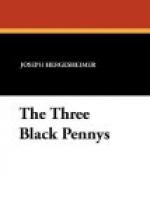II
He was possessed by an unaccustomed desire to be at Myrtle Forge; usually it was the contrary case, and he was escaping from the complicated civilisation of his home; but now the well-ordered house, the serenity of his room, appeared astonishingly inviting. Howat progressed rapidly past the smithy, and turned to the right, about the Furnace dam, a placid and irregular reach of water holding the reflection of the trees on a mirror still dulled by a vanishing trace of mist, above which the leaves hung in the motionless air, in the aureate wash of the early sun, as if they had been pressed from gold foil. Beyond the dam the path—he had left the road that connected Forge and Furnace for a more direct way—followed the broad, rippling course of the Canary, the stream that supplied the life of Myrtle Forge. He automatically avoided the breaks in the rough trail; his mind, a dark and confused chamber, still lighted by appalling flashes of memory. A thing as slight, as incalculable, as a loose flint had been all that prevented.... He wondered if Fanny and Thomas Gilkan were right in their shared conviction; Fanny half persuaded, but the elder with a finality stamped with an accent of the heroic. Whether or not they were right didn’t concern him, he decided; his only problem was to keep outside all such entanglements. And at present he wanted to sleep.
The path left the creek and joined the road that swept about the face of the dwelling at Myrtle Forge. The lawn, squarely raised from the public way by a low brick terrace, showed the length of house behind the dipping, horizontal branches, the beginning, pale gold, of a widespread beech. It was a long structure of but two stories, built solidly out of a dark, flinty stone with an indefinite pinkish glow against the lush sod and sombre, flat greenery of a young English ivy about a narrow, stiff portico.
Howat crossed the lawn above the house, where a low wing, holding the kitchen and pantries, extended at right angles from the dwelling’s length. A shed with a flagging of broad stones lay inside the angle, where a robust girl with an ozenbrigs skirt caught up on bare legs and feet thrust into wooden clogs was scrubbing a steaming line of iron pots. He quickly entered the centre hall from a rear door, and mounted, as he hoped, without interruption to his room. That interior was singularly restful, pleasant, after the confused and dishevelling night.
The sanded floor, patterned with a broom, held no carpet, nor were the walls covered, but white and bare save for a number of small, framed engravings—a view of Boston Harbour, Queene Anne’s Tomb, and some black line satirical portrait prints. A stone fireplace, ready for lighting, had iron dogs and fender, and a screen lacquered in flowery wreaths on a slender black stem. At one side stood a hinge-bound chest, its oak panels glassy with age; on the other, an English set of drawers held a mirror stand and scattered trifles—razors and gold sleeve-buttons, a Barcelona handkerchief, candlesticks and flint, a twist of common, pig-tail tobacco; while from a drawer knob hung a banian of bright orange Chinese silk with a dark blue cord.




